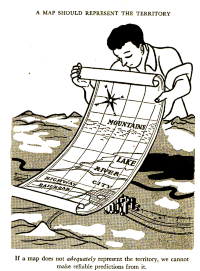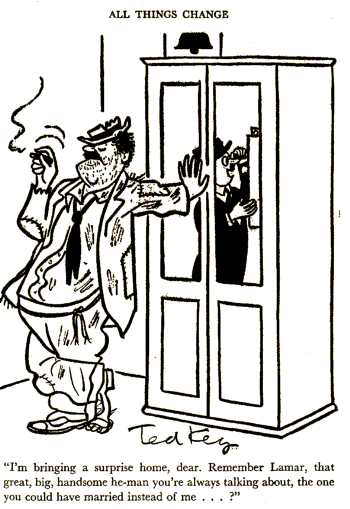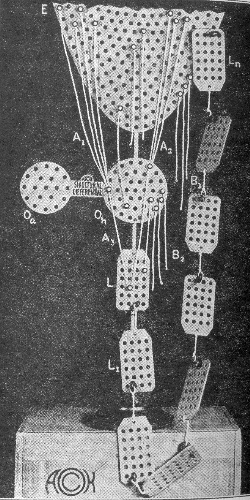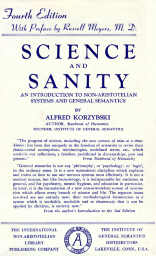"The map is not the territory." That was my first introduction to the work of Count Alfred Korzybski. I heard those words in a Bandler and Grinder(1) Seminar in 1977 and borrowed a copy of this
landmark book, his major opus, first published in 1933 from a friend. He had been directed
to it by our mutual metaphysics teacher, Alex Keller, some years earlier. I dug into the text of this 806 page
book which had 657 references and 90 pages of Preface and Introductions. Suddenly the basis for the works
of Samuel Bois, Kenneth S. Keyes, and S. I. Hayakawa began to make new sense for me — all these writers
had studied under Korzybski. They were enriching his fundamental work and making it palatable to the
general public.
Korzybski's work created the field of General Semantics, which became known as a science
and was taught in colleges and universities. Somehow I had missed it, up until then. I was determined to
work my way through this book to make up for lost time and work I did: it took me an entire year of study
to get through this dense book — dense in the compression of ideas in it. So dense that many days I was
only able to read three or four pages and then had to stop because my brain was so full of ideas that I had
to pause for 24 hours for them to be assimilated fully before I could proceed. And each day I applied those
ideas and processes to as many situations as came up in my life during that day. It was, rightly understood,
a year long seminar in General Semantics for me. In this review I hope to give you, my dear Readers, a taste
of that seminar so that the flavor of this important science can remain with you and bring some sanity into
the science that abounds all around and inside of you from now on.
One of the rare occasions we get to read an author talking about the book we are reading is in Prefaces to
Second and Third Editions. After reading this book, I read the precursor to it, a smaller book
he wrote in 1921 entitled, "Manhood of Humanity," in which Korzybski talked about the process of "time
binding." Time binding was to Korzybski like a single string on a guitar — he used it as the basis of the
music he made in all of his works. "Science and Sanity" was a symphony he composed for his one-string
guitar. In his Preface to the Third Edition (1948), he talks about this book from the perspective of 15 years after its publication:
[page xx] The origin of this work was a new functional definition of 'man', as
formulated in 1921, based on an analysis of uniquely human potentialities; namely,
that each generation may begin where the former left off. This characteristic I called
the 'time-binding' capacity. Here the reactions of humans are not split verbally and
elementalistically into separate 'body', 'mind', 'emotions', 'intellect', 'intuitions', etc.,
but are treated from an organism-as-a-whole-in-an-environment (external and
internal) point of view. This parallels the Einstein-Minkowski space-time integration
in physics, and both are necessitated by the modern evolution of sciences.
His new definition of what it means to be a human being pinpointed an aspect of humanity that the
evolutionists, who were apt to call us "higher apes," had completely glossed over in their intense concern
with the bones and flesh aspect of evolution, i.e., our posture, our brain size, our skull shapes, etc. What
Korzybski stressed in his 1921 work was a process that humans had and that animals did not possess, time
binding. It is the process of time binding that allows each generation to see further because they "stand on
the shoulders" of the previous generation.
With this present book, Korzybski sought to create the foundation for a "science of man" by linking
science and sanity in a "structurally non-aristotelian methodology." To achieve that he added to the process
of time-binding, the "general consciousness of abstracting", which he calls on page xxi, "the thesis of this
book". He quotes Whitehead to support his claim of the importance of understanding the process of
abstracting:
[page xxi] 'A civilisation that cannot burst through its current abstractions is doomed
to sterility after a very limited period of progress.'
This is a remarkable statement. If one applies it to the field of art, one can see representations of art's
current abstractions embodied in the visual arts of painting and sculpture. These abstractions show
themselves in the way current paintings are made based upon the original works of Rembrandt, Picasso,
Monet, or Van Gogh. When an innovator in art comes along to create a new abstraction, such as Mondrian,
Pollock, or Warhol, a period of exciting innovation proceeds for a limited period of time. I have described
this process in the field of art in my essay, Art is the Process of Destruction, which essay would likely have
been impossible but for the year I spent working through this book which first made me aware of the
process of abstraction.
To understand the non-Aristotelian systems that Korzybski develops in this work, we first need a
priming on the Aristotelian system that pervades our current level of thinking, teaching, and abstracting.
Simply put the Aristotelian system is two-valued: either-or, yes-no, day-night, life-death, black-white, etc.
The prevalence of the two-valued system of thinking puzzled Korzybski for many years, he says, until he
"made the obvious 'discovery' that our relations to the world outside and inside our skins often happen to
be, on the gross level, two-valued." But he added something more to the Aristotelian two-valued system,
and that something more makes all the difference in the world to what it means to be a living human being:
[page xxi] In living, many issues are not so sharp, and therefore a system which posits
the general sharpness of 'either-or' , and so objectifies 'kind', is unduly limited; it must
be revised and made more flexible in terms of 'degree'. This requires a physico-mathematical 'way of thinking' which a non-aristotelian system supplies.
While Korzybski developed his work independently of semantics or semiotics, he admits that, as his
work progressed, it became obvious to him that "a theory of meaning" was impossible. As such, he thought
it necessary to explain the derivation of the name "General Semantics" for his corpus of work.
[page xxii] The original manuscript did not contain the word 'semantics' or 'semantic',
but when I had to select some terms, from a time-binding point of view and in
consideration of the efforts of others, I introduced the term 'General Semantics' for
the modus operandi of this first non-aristotelian system. This seemed appropriate for
historical continuity. A theory of evaluation appeared to follow naturally in an
evolutionary sense from 1) 'meaning to' to 2) 'significance' to 3) evaluation. General
Semantics turned out to be an empirical natural science of non-elementalistic
evaluation, which takes into account the living individual, not divorcing him from his
reactions altogether, nor from his neuro-linguistic and neuro-semantic environments,
but allocating him a plenum of some values, no matter what.
From this passage in his Introduction to the Second Edition (1941) one can understand the paradox
faced by an author who develops a truly unique science — to communicate to the average intelligent reader,
and also to the specialists in the very fields that are impacted by the new science. The paradox is this: those specialists, who
ought to be better able to understand it, are less able to understand it than the average reader. Philosophers,
who ought to be able to understand any new field of science, are often the last ones to grasp it, so stuffed
full of their own verbalizations as to be unable to comprehend the thoughts of anyone with a truly new idea,
as Korzybski presented them with.
[page xxviii] Most 'philosophers' who reviewed this book made particularly shocking
performances. Average intelligent readers can understand this book, as they usually
have some contact with life. It is not so with those who indulge in mere verbalism.
Korzybski gives a salient example of one of those philosopher-penned reviews and shows how
error-prone it is and how it completely misses the point of his work. For those of you who are still not sure
what his point is, here is an excellent summary of it:
[page xxix] Most 'philosophers', 'logicians', and even mathematicians look at this non-aristotelians system of evaluation as some system of formal non-aristotelian 'logic',
which is not the case. They are somehow not able to take the natural science point of
view that all science, mathematics, 'logic', 'philosophy', etc., are the product of the
functioning of the human nervous system, involving some sort of internal orientations,
or evaluations, which are not necessarily formalized. The analysis of such living
reactions is the sole object of general semantics as a natural empirical science.
Not only do these philosophers miss the point entirely, but by doing so, they will continue to heap
untold damage upon future generations of our youth by teaching them about "identity" — something which
Korzybski clearly demonstrates within the covers of this book — is non-existent in the world, except in the
minds and processes of philosophers and mentally deranged human beings.
[page xxix] These 'philosophers', etc., seem unaware, to give a single example, that by
teaching and preaching 'identity', which is empirically non-existent in this actual
world, they are neurologically training future generations in the pathological
identifications found in the 'mentally' ill or maladjusted. As explained on page 409,
and also Chapter XXVI, whatever we may say an object 'is', it is not, because the
statement is verbal, and the facts are not.
Words are like maps. If a map is not the territory it represents, a word is not the object it represents.
Also a map cannot contain all of the territory — it can only hope to represent the structure of the territory.
[page 38] Two important characteristics of maps should be noticed. A map is not the
territory it represents, but, if correct, it has a similar structure to the territory, which
accounts for its usefulness. If the map could be ideally correct, it would include, in a
reduced scale, the map of the map; the map of the map of the map; and so on,
endlessly, a fact first noticed by Royce.
What does all this mean? you ask. Is this important? The answer is yes, because the presence of
aristotelian systems has kept civilization itself at the level of a dumb animal, up until now. If you will read
the first 62 pages of this book, no doubt you will agree with this next statement, as I did:
[page 62] The present analysis shows that, under the all-pervading aristotelianism in
daily life, asymmetrical relations, and thus structure and order, have been impossible,
and so we have been linguistically prevented from supplying the potentially 'rational'
being with the means for rationality. This has resulted in a semi-human so-called
'civilization', based on our copying animals in our nervous process, which, by
necessity, involves us in arrested development or regression, and, in general,
disturbances of some sort.
Once upon a time, the geometry of Euclid was the geometry of space, the universe of Newton was
the Universe. With the advent of Lobatchevski and Einstein the geometry of Euclid proved to be only a
geometry of space and the universe of Newton proved to be a way of looking at the Universe.
[page 86] It is not difficult to see that in all these advances there is a common
characteristic, which can be put simply in that it consists in a little change from a 'the'
into an 'a'. Some people insist upon sentences in one-syllable words; here we could
indeed satisfy them! The change, no doubt, can be expressed by the exchange of one
syllable for another. But the problems, in spite of this apparent simplicity, are quite
important; and the rest of this volume will be devoted to the examination of this
change and of what it structurally involves.
For any readers who are still not clear on the distinction between Plato and Aristotle's approach to
philosophy, Korzybski gives us an excellent thumbnail. Since he claims to have created non-Aristotelian
systems, it is necessary to understand the tenets of an Aristotelian system.
[page 87] Psycho-logically, Aristotle was a typical extrovert, who projects all his
internal processes on the outside world and objectifies them: so his reaction against
Plato, the typical introvert, for whom 'reality' was all inside, was a natural and rather
an inevitable consequence. The struggle between these two giants was typical of the
two extreme tendencies which we find in practically all of us, as they represent two
most diverse, and yet fundamental psycho-logical tendencies.
In his explanation below of how these two extreme tendencies show up in our lives, Korzybski uses
several words which one must come to terms with in order to make full use of the contents of this book.
He uses them so often in the book that he adopted shorthand abbreviations for them. When these appear
in the passage below I will enclose the full word in [brackets] the first time they appear.
[page 87] In 1933 we know that either of these extremes in our make-up is undesirable
and un-sound, in science as well as in life. In science, the extreme extroverts have
introduced what might be called gross empiricism, which, as such, is a mere el
[elementalistic] fiction — practically a delusion. For no 'facts' are ever free from
'doctrines': so whoever fancies he can free himself from 'doctrines', as expressed in
the structure of the language he uses ., [etc. ,] simply cherishes a delusion, usually with
strong affective components. The extreme introverts, on the other hand, originated
what might be called the 'idealistic philosophies', which in their turn become el
delusions. We should not overlook the fact that both these tendencies are el and
structurally fallacious. Belief in the separate existence of el, and, therefore, fictitious,
entities must be considered as a structurally un-sound s.r [semantic reaction] and
accounts in a large degree for many bitter fights in science and life.
The exact meaning of terms such as el, m.o, s.r require a close reading of the first chapters of the
book, but I will hazard a simple explanation of these three important and often used terms. An
elementalistic [el] term is one in which in our semantic reactions [s.r] we ignore the multiordinal [m.o]
aspects of it. This makes it possible for us to understand the triad if we can get our hands around what a
multiordinal term is. Luckily he provides a concise definition of his discovery of multiordinality in this next
passage:
[page 14] Terms like 'yes', 'no', 'true', 'false', fact', 'reality', 'cause', 'effect',
'agreement', 'disagreement', 'proposition', 'number', 'relation', 'order', 'structure',
'abstraction', 'characteristic', 'love', 'hate', 'doubt', etc., are such that if they can be
applied to a statement they can also be applied to a statement about the first statement,
and so, ultimately, to all statements, no matter what their order of abstraction is.
Terms of such a character I call multiordinal terms.

If it makes your head ache trying to keep all these terms like balls juggling in the air at the same
time, you will understand why I found it difficult to work through more than a couple of pages at a time
when I first read this book. And you may be wondering how any of this could ever be useful to the average
person who can not or will not take the immense effort it takes to understand the work of this phenomenal
thinker, and you would be right. Luckily he taught some brilliant people like Samuel Bois, S. I. Hayakawa,
and Kenneth Keyes who were able to bring his work down to a practical and easy to understand level. For
beginners I suggest Keyes's book, "How to Develop Your Thinking Ability" which is available currently
under the title, "Taming Your Mind".This book covers the important bases of "Science and Sanity" in
simple everyday words using cartoons to illustrate the main points. I utilized this book during a course
in "Effective Communication" I gave to hundreds of maintenance people at Waterford 3 Nuclear Power
Station in the 1980s(2).
Another essential phrase to come to terms with is semantic reaction [s.r], which refers to affective
disturbances in persons related to their failure to recognize the intention, goal, or meaning of the words they
receive from another. To Korzybski these disturbances were failures in the education system which he
systematically set about to correct.

[page 20] Disturbances of the semantic reactions in connection with faulty education
and ignorance must be considered in 1933 as sub-microscopic colloidal lesions.
Note his use of the time index above (See All Things Change Cartoon) by his specifying the date during which his writing applies to
the world.
Max Planck said in his autobiography, "A new scientific truth does not triumph by convincing its
opponents and making them see the light, but rather because its opponents eventually die, and a new
generation grows up that is familiar with it." [italics added] One of the reasons for this paradoxical condition
of science is that scientists are human beings and subject to semantic reactions and every new system
involves the learning of new semantic reactionswhich scientists have proven to be as slow at learning as
the average ditch-digger. Korzybski gives us a scientific way of understanding what we mean by the
expression which Planck used above, "familiar with":
[page 27] Any fundamentally new system involves new s.r; and this is the main
difficulty which besets us when we try to master a new system. We must re-educate,
or change, our older s.r. As a rule, the younger generation, which began with the new
s.r, has no such difficulties with the new systems. Just the opposite — the older s.r
become as difficult or impossible to them as the new were to the older generations.
Another great discovery of Korzybski is the deleterious effects of identification. He says while
identification may be useful to babies and children, it proves harmful to adults. We can easily notice when
we are using identification because in English we will use the verb "to be" to create the identity. Some have
suggested a convention be adopted in English in which we consciously avoid using the verb "to be" for
identification, which form of English is called "english prime" or simply, e'. Try it sometime, and you may
find it a very useful process — to write for a long time without using the verb "to be" for identification.
Why is this important? The good news is that it's only important if you're an adult.

[page 202] The 'is' of identity plays a great havoc with our s.r, as any 'identity' is
structurally false to fact. An infant does not know and cannot know that. In his life,
the 'is' of identity plays an important semantic role, which, if not checked intelligently,
becomes a pernicious semantic factor in his grown-up reactions, which preserve the
infantile character and with which adult adjustment and semantic health is impossible.
Perhaps the greatest discovery of all was the process of abstracting. Korzybski talked about the
world outside of us as being the "What Is Going On" or WIGO for short. That is the world before it is
experienced by anyone. To have a non-verbal representation of the process of abstraction, Korzybski
created a diagram he called the Structural Differential, of which a photograph is shown in Figure 5, page
398. It is definitely worthwhile to take some time to study
this figure and its description.
Here is my thumbnail of abstracting: the parabola extending to infinity is the WIGO, from which
a human perceives an Object, shown by the circular plate, Oh, which is connected to WIGO. The human
creates the first level of abstraction by giving the Object a label, shown by the rectangular plate L which
has some connecting wires to Oh. As higher levels of abstraction are created, new plates, L1, L2, ... Ln are
shown, with Ln finally ending up back connected to the WIGO parabola, because it is a part of the What
Is Going On.
This is not the end of understanding General Semantics, only the beginning. We have only inspected
the foundations of this mansion and a couple of its room. Only by living inside it for a few years and
learning all its hidden corners and useful appliances will you come to appreciate the structure that Alfred
O. Korzybski has built for humankind. You have had the key to this house placed in your hand; it is up to
you to open the door and begin your personal adventure into science and sanity.
---------------------------- Reference Links for Alfred Korzybski ---------------
A Reference Page of Material
written by Bobby Matherne
on Science and Sanity
and its Author, Alfred Korzybski
http://www.doyletics.com/arj/aoklinks.htm
~^~
---------------------------- Footnotes -----------------------------------------
Footnote 1.
The subject of their seminar, unnamed in 1977, later became known as neuro-linguistic programming, and it's clear from the page xxii passage that Korzybski's work had a hand in forming this field as well as its label.
Return to text directly before Footnote 1.
~~~~~~~~~~~~~~~~~~~~~~~~~~~~~~~~~~~~~~~~~~~~~~
Footnote 2.
The cartoons were at one-time available on-line thanks to the International Society for General Semantics at:
http://www.generalsemantics.org/ — I heartily recommend that readers take the time to visit the website.
Return to text directly before Footnote 2.
~~~~~~~~~~~~~~~~~~~~~~~~~~~~~~~~~~~~~~~~~~~~~~
~^~
Any questions about this review, Contact: Bobby Matherne
~~~~~~~~~~~~~~~~~~~~~~~~~~~~~~~~~~~~~~~~~~~~~~~~~~~~~~~~~~

 == == == == == == == == == == == == == == == ==
== == == == == == == == == == == == == == == ==
22+ Million Good Readers have Liked Us
22,454,155
as of November 7, 2019
Mo-to-Date Daily Ave 5,528
Readers
For Monthly DIGESTWORLD Email Reminder:
Subscribe! You'll Like Us, Too!
== == == == == == == == == == == == == == == ==
Click Left Photo for List of All ARJ2 Reviews Click Right Bookcover for Next Review in List
Did you Enjoy this Webpage?
Subscribe to the Good Mountain Press Digest: Click Here!


CLICK ON FLAGS TO OPEN OUR FIRST-AID KIT.
All the tools you need for a simple Speed Trace IN ONE PLACE. Do you feel like you're swimming against a strong current in your life? Are you fearful? Are you seeing red? Very angry? Anxious? Feel down or upset by everyday occurrences? Plagued by chronic discomforts like migraine headaches? Have seasickness on cruises? Have butterflies when you get up to speak? Learn to use this simple 21st Century memory technique. Remove these unwanted physical body states, and even more, without surgery, drugs, or psychotherapy, and best of all: without charge to you.
Simply CLICK AND OPEN the
FIRST-AID KIT.

Counselor? Visit the Counselor's Corner for Suggestions on Incorporating Doyletics in Your Work.

All material on this webpage Copyright 2019 by Bobby Matherne








